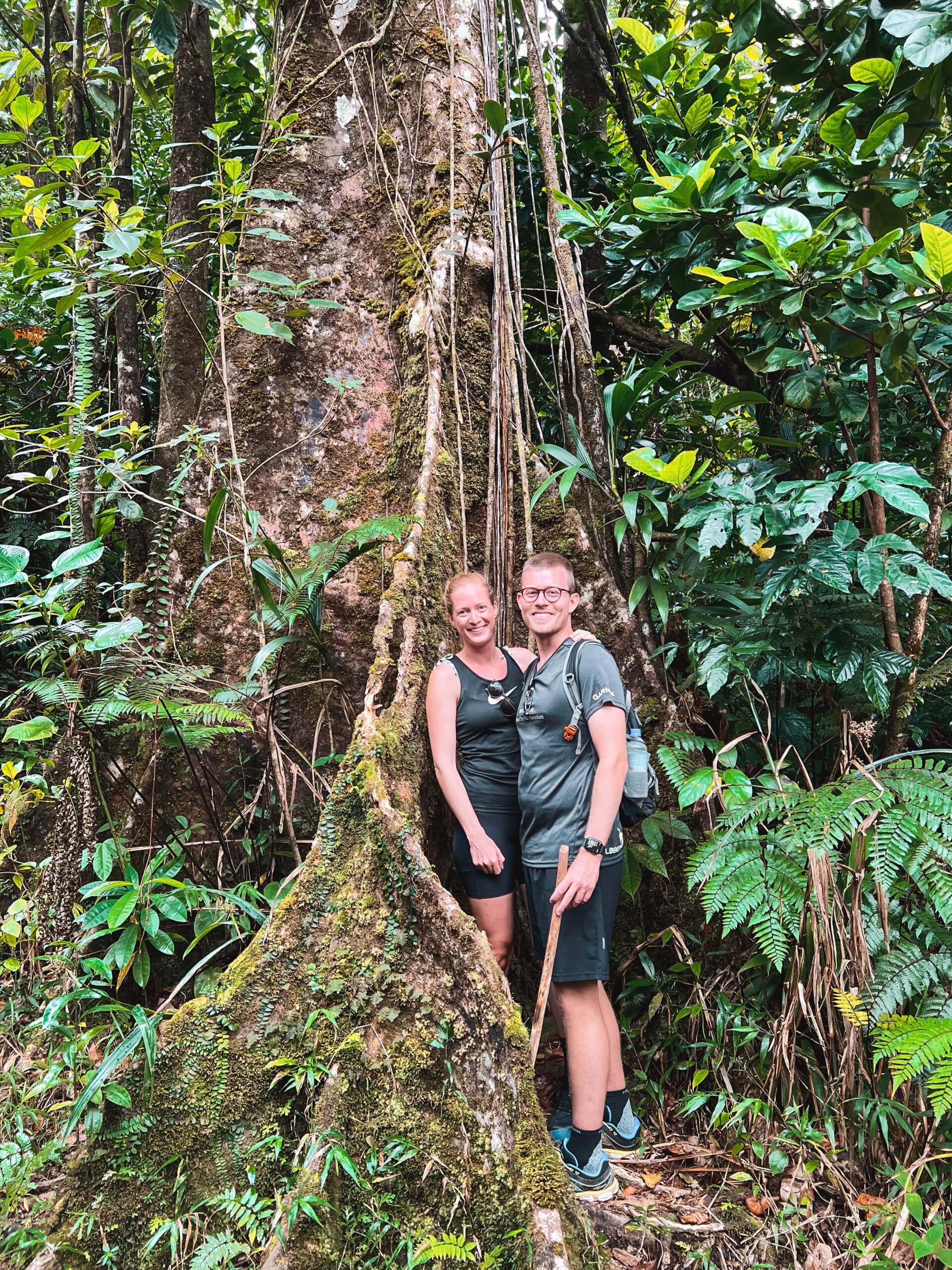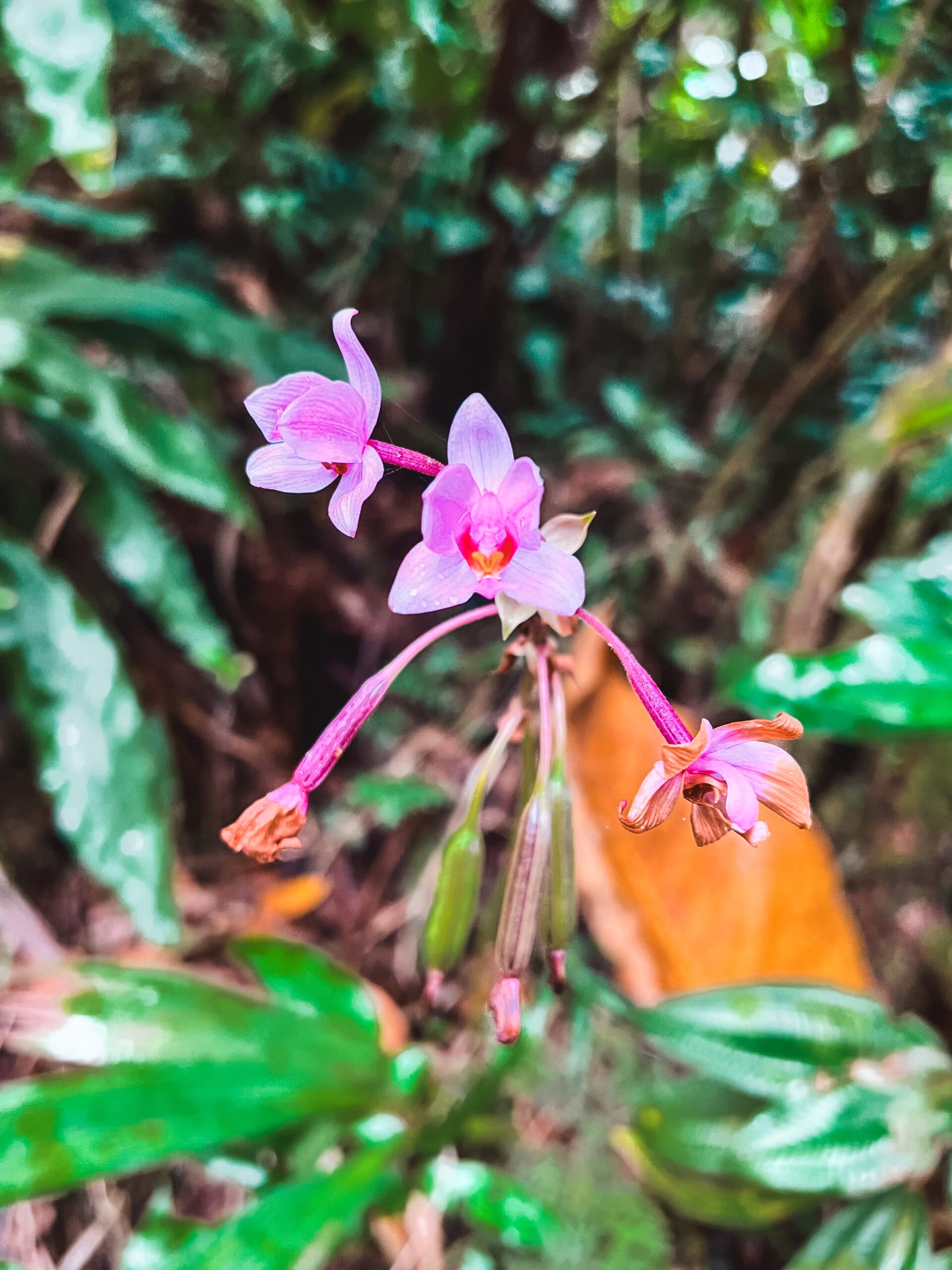Welcome to the Nature Island of the Caribbean – Dominica!
Home to no less than 365 rivers and 9 active volcanoes. It was these volcanoes that particularly caught our interest as we set our course towards the most mountainous island in The Lesser Antilles. Dominica is full of volcanic activity, and when Rasmus found out that we could visit the Boiling Lake, he was unstoppable.
The preparations
On a (very) early Monday morning, we packed the car and set off towards Morne Trois Pitons National Park. The 7,000-hectare national park is listed as a UNESCO World Heritage Site for its magnificent nature and rich biodiversity. We were completely dazzled by the prospect of experiencing an actual boiling lake and had therefore not given much thought to the surrounding nature. After just over a week in Dominica, we had already had a glimpse of the beauty of the island, but what awaited us was of a completely different caliber.
The Boiling Lake was at the very top of the list of things we had to see in Dominica, so we were determined to be well prepared for the hike. We both studied the trip before we set off by reading various travel blogs and trivia sites. It was emphasized that the route could be difficult to navigate on your own and the advice was: “Get a guide!” So we did. With us on this adventure, we had our local guide Chadi, who would lead us unscathed through the 13-kilometer hike.
After picking up Chadi in our rented 4×4, we headed inland. Along the way, he briefed us on what the day would entail. Ahead of us was 7-8 hours of hiking with increasing difficulty. The route consisted of three stages:
We parked the car at Titou Gorge, which is itself a major attraction in Dominica. However, the tempting water had to wait until later, which suited me just fine as it was a cool morning. Covered in sunscreen and with our backpacks filled with water, snacks, and mosquito repellant(!), we set out on the route’s first and easiest stage.


Rainforests and orchids
The first part of the route led us into the rainforest with a light drizzle from the clouds above us. It seemed perfect to start this iconic hike by being engulfed in the damp forest. The rest of the world ceased to exist, and we were now surrounded by the soothing silence of nature.
The trail steadily climbed up between giant châtaignier trees with roots taller than ourselves. We tested our skills as Tarzan and Jane as we swung on vines and were amazed at how sturdy they were. Chadi eagerly told us about the different plants we encountered on our way and pointed out wild orchids. It was crazy to see this otherwise fragile flower thrive right in front of us. The very same flower that in Danish potted plants is so sensitive to the amount of sunlight and water. We were right in the middle of its natural habitat. Or rather, we were in the natural habitat of all our old houseplants. It almost became a sport to identify the plants we recognized from Rasmus’ office or our previous home in Denmark. The difference was that on Dominica they were huge!
We learned about the significance of the gommier tree for Dominica’s indigenous people, the Kalinagos. The tree was and still is used to make dugout canoes. The trunk is hollowed out using small controlled fires. The fire makes the wood softer to work with and easier to scrape out. The resin from the gommier has a wax-like consistency and is highly flammable. The Kalinagos used it to make torches and light fires. Chadi demonstrated the resin’s abilities by creating a homemade match and lighting it. Interestingly enough, the tree is also commonly known as candlewood.
The first part of our hike reached its conclusion when we crossed the Breakfast River, where the water lazily flowed in the morning sun. From this point on, there was only one way to go to reach the Boiling Lake – and that was up!


The climb
Our legs were now put to the test as we faced Morne Nicholls. The elevation was in sharp contrast to the gentle climb of the first stage. The flat Danish terrain paled in comparison to Morne Nicholls’ 966 meters, which easily made the sweat trickle. Morne Nicholls is Dominica’s seventh highest mountain. It is named after the medical doctor Sir Henry Alfred Alford Nicholls, who reportedly was the first to discover the Boiling Lake in the late 1800s. Perhaps the Kalinagos have a slightly different perception of that?
Although we were helped by the steps carved into the mountain side, it still required a lot of effort to get up the steep route. Despite the lactic acid in our legs, the view captivated our attention and made us forget our shortness of breath. At the top, we took a well-deserved break and refueled. Not only did we have a view of the capital city of Roseau, but we also got the first glimpse of the day’s main attraction as we saw a plume of steam rising in the distance.
The descent was almost as difficult as the ascent, and the trail was almost hidden after repeated landslides and rainfall. We had to use our hands to get down the muddy and uneven mountainside. The route was slippery, and we had to be careful not to fall flat on our asses. But wow, what a sight awaited us after the descent.

Jurassic Park meets The Lord of the Rings
As if taken straight from Tolkien’s universe, the third stage of our hike lay ahead of us: The Valley of Desolation. And yes, it was just as dramatic as it sounds! The sight of this almost apocalyptic wasteland that revealed itself in front of us left us speechless. Were we actually on our way to Mordor?
The valley we were about to cross was shaped by three craters from active volcanoes. A completely unearthly landscape, complete with billowing clouds of steam. The area served as a giant vent for the surrounding volcanoes, thus reducing the risk of actual eruptions. The pressure in the active volcanoes was simply kept down by venting steam and gas through cracks in the ground beneath our feet. The valley was almost devoid of vegetation due to the sulfuric gases and was instead painted like the rainbow by sulfur, iron, and carbon from deep under ground.
This was the stretch which could be difficult to navigate without a guide. The place was full of small boiling springs, heated by the magma of the volcanoes. Not exactly the place you wanted to misstep.
The sulfuric gases made the whole valley smell strongly of eggs. Very appropriately, Chadi pulled out three eggs from his backpack, which he delicately wrapped in leaves and placed in one of the boiling springs. “Snacks for the trip back,” he told us.

Out of the frying pan, into the fire
On the other side of the valley, we walked along small waterfalls and crystal-clear streams in which the cold water from the mountains met the boiling springs and created small hot pools. We crossed several rivers, and Chadi pointed out hidden holes with volcanic mud. With homemade face masks, we decended the last steep slopes with the help of ropes.
At long last, we reached the main goal of the day. The Boiling Lake was almost invisible in the huge cloud of steam that first greeted us. However, a gentle breeze gave us a sneak peek at the 60-meter-wide lake and its thundering surface – a magnificent and yet intimidating sight. The temperatures along the edge of the lake are around 82-92 degrees Celsius, while the fiercely boiling center has been impossible to measure. The Boiling Lake is the second-largest of its kind, surpassed only by Frying Pan Lake in New Zealand, which we immediately added to our bucket list.
Experiencing the lake was one of those moments where you can’t quite believe your own eyes. Could it really be true that these massive amounts of water in front of us were boiling? It took an enormous amount of energy to heat a lake of that size. Considering an actual volcanic eruption, it was not that unbelievable after all, though even more frightening.


Back to the beginning
We had sweated for half a day to reach our final destination. Now, we had to do it all over again, this time in the scorching afternoon sun. It may sound like a tedious and tough affair, but once again, Chadi proved his worth. On our way back to The Valley of Desolation, he showed us a semi-hidden hot spring we could bathe in. The small pool and its waterfall looked like something from a painting. Our sore legs got a much-needed rest, and our face masks were washed off.
Our legs got a boost, and now our stomachs needed the same. Our (very) hard-boiled eggs were ready to give us a shot of protein before we faced Morne Nicholls’ steep climb once again. At the top, Chadi supplied us with Skittles, and even though we were getting quite tired, our spirits were still high.
After 6 hours and 20 minutes, we finally made it back to the starting point and could take a dip in Titou Gorge. The cool water was pure magic after the warm hike, and we took our time floating around. As mentioned earlier, the gorge is an attraction in itself. It was at this spot no other than Orlando Bloom himself splashed around during the filming of Pirates of the Caribbean. I will save that story for another time though.


Tired and thoroughly impressed
A long hike had come to an end. We were completely overwhelmed! Our heads were filled with impressions and new knowledge. We stocked up on chocolate and freshly made passion fruit juice before dropping off Chadi in Roseau and heading north to our accommodation. Did we need a guide to navigate? No, not really, but we don’t regret our choice at all. The stories along the way and the fun moments were worth it all.
After an endless drive, we finally arrived at the apartment. We were ready to dive headfirst into bed with sore legs and incredibly soft skin on our faces. It’s a good thing we didn’t know at that time how sore our bodies would be the next day.

1 thought on “The Boiling Lake”
Pingback: Meeting Señor Fuego - UDVE